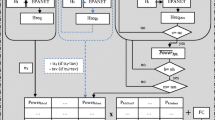Abstract
The optimal design for pressurized irrigation subunits is a complicated problem that not only requires a confirmation of the layout but also requires a pipe diameter combination. Using a subunit with single lateral and a subunit with paired laterals as research objects, four mathematical optimization models were established to identify the optimal microirrigation subunit design. The optimization criteria were minimizing the annual total cost (CT) and maximizing the subunit size (A); it was assumed that all the emitters have equal discharge, and only rectangular subunits were considered in this study. No allowable pressure differences allocation between the lateral and the manifold were made in this study, considering that there are many factors that affect the distribution ratio and the overall optimization of the subunit. A genetic algorithm was used to obtain the optimal design when simultaneously considering the layout and pipe diameters of the subunit. The results indicated that the investment cost (Ca) is the most important factor, and it makes up 43–66% of the CT, followed by the water cost (Cw), which accounts for 28–49% of the CT. A subunit with paired laterals is superior to a subunit with single lateral in terms of both the total cost and the control area. On the whole, with the increase in the lateral diameter, both the total cost and the control area will increase. With an increase in the emitter discharge, the total cost increases, while the control area decreases. The change of slope in the lateral direction has little effect on the total cost and control area. The method proposed in this study is applicable to the simultaneous optimization of the subunit in which the layout and area are undetermined, and it may provide a new path towards subunit optimization.






Similar content being viewed by others
References
Baiamonte G, Provenzano G, Rallo G (2014) Analytical approach determining the optimal length of paired drip laterals in uniformly sloped fields. J Irrig Drain Eng 141(1):04014042
Bralts VF, Segerlind LJ (1985) Finite element analysis of drip irrigation submain units. Trans ASAE 28(3):809–814
Bralts VF, Kelly SF, Shayya WH, Segerlind LJ (1993) Finite element analysis of microirrigation hydraulics using a virtual emitter system. Trans ASAE 36(3):717–725
Carrión F, Tarjuelo JM, Hernández D, Moreno MA (2013) Design of microirrigation subunit of minimum cost with proper operation. Irrig Sci 31(5):1199–1211
Carrión F, Montero J, Tarjuelo JM, Moreno MA (2014) Design of sprinkler irrigation subunit of minimum cost with proper operation. Application at corn crop in Spain. Water Resour Manag 28(14):5073–5089
Jiang ZQ, Ji CM, Qin H, Feng ZK (2018a) Multi-stage progressive optimality algorithm and its application in energy storage operation chart optimization of cascade reservoirs. Energy 148:309–323
Jiang ZQ, Li RB, Li AQ, Ji CM (2018b) Runoff forecast uncertainty considered load adjustment model of cascade hydropower stations and its application. Energy 158:693–708
Ju XL, Paul WR, Wu PT, Zhu DL, Wang XK, Li Z (2015) New simplified approach for hydraulic design of microirrigation paired laterals. Trans ASABE 58(6):1521–1534
Keller J, Bliesner RD (1990) Sprinkle and trickle irrigation. Van Nostrand Reinhold, New York
Li YN, Ma PH, Hu YJ, Yu CF (2016) Optimal design of the gravity micro-irrigation pipe network for irrigation district. J Hydraul Eng 47(11):1371–1379 (in Chinese)
Li RB, Jiang ZQ, Ji CM, Li AQ, Yu S (2018) An improved risk-benefit collaborative grey target decision model and its application in the decision making of load adjustment schemes. Energy 156:387–400
Masoumi M, Kashkooli BS, Monem MJ, Montaseri H (2016) Multi-objective optimal design of on-demand pressurized irrigation networks. Water Resour Manag 29(14):1–13
Ministry of Housing and Urban-Rural Development of the People’s Republic of China, General Administration of Quality Supervision, Inspection and Quarantine of the People’s Republic of China (2009) GB/T 50485 — 2009, Technical code for microirrigation engineering[S]. Beijing: China Planning Press (in Chinese)
Monserrat J, Barragan J, Cots L (2018) Design of paired laterals on uniformly sloping fields. J Irrig Drain Eng 144(6):04018008
Nakayama FS, Bucks DA (1986) Trickle irrigation for crop production, design, operation and management. Elsevier Science, Amsterdam
Singh A, Singh RP, Mahar PS, Singh KK (2000) Optimal design of tapered microirrigation submain manifolds. J Irrig Drain Eng 126(6):371–374
Tarjuelo JM, de Juan JA, Moreno MA, Ortega JF (2010) Water resources deficit and water engineering. Span J Agric Res 8(S2):102–121
Tu Q, Li H, Wang XK, Chen C (2015) Ant colony optimization for the design of small-scale irrigation systems. Water Resour Manag 29(7):2323–2339
Valiantzas JD (2003) Explicit hydraulic design of microirrigation submain units with tapered manifold and laterals. J Irrig Drain Eng 129(4):227–236
Watters GZ, Keller J (1978) Trickle irrigation tubing hydraulics. ASAE technical paper 78–2015. American Society of Agricultural Engineers, St. Joseph
Wu IP (1992) Energy gradient line approach for direct hydraulic calculation in drip irrigation design. Irrig Sci 13(1):21–29
Wu IP (1997) An assessment of hydraulic design of microirrigation systems. Agric Water Manag 32(3):275–284
Wu IP, Gitlin HM (1977) Design of drip irrigation lines with varying pipe sizes. J Irrig Drain Div 103(4):499–503
Wu PT, Zhu DL, Wang J (2010) Gravity-fed drip irrigation design procedure for a single-manifold subunit. Irrig Sci 28(4):359–369
Zhang L, Wu PT, Zhu DL (2013) Hydraulic design procedure for drip irrigation submain unit based on relative flow difference. Irrig Sci 31(5):1065–1073
Acknowledgements
This research was supported by the Special Fund for Agro-scientific Research in the Public Interest (Grant numbers: 201503105 and 201503125). The authors would also like to thank the anonymous reviewers for their helpful comments.
Author information
Authors and Affiliations
Corresponding author
Ethics declarations
Conflict of Interest
None.
Additional information
Publisher’s Note
Springer Nature remains neutral with regard to jurisdictional claims in published maps and institutional affiliations.
Rights and permissions
About this article
Cite this article
Ma, P., Hu, Y. & Liu, H. Optimal Design for Pressurized Irrigation Subunits with a Minimum Cost and Maximum Area for Uniformly Sloping Fields. Water Resour Manage 33, 2711–2726 (2019). https://doi.org/10.1007/s11269-019-02243-6
Received:
Accepted:
Published:
Issue Date:
DOI: https://doi.org/10.1007/s11269-019-02243-6




